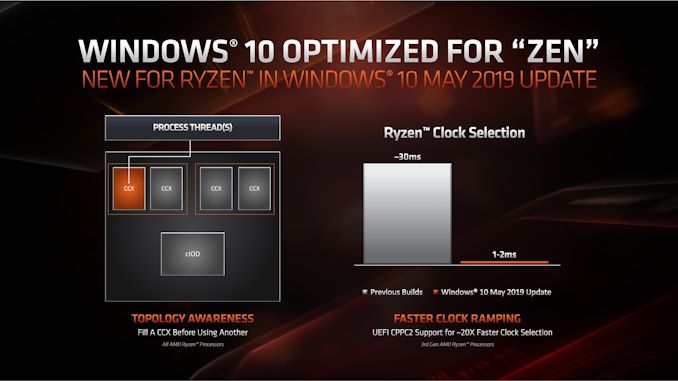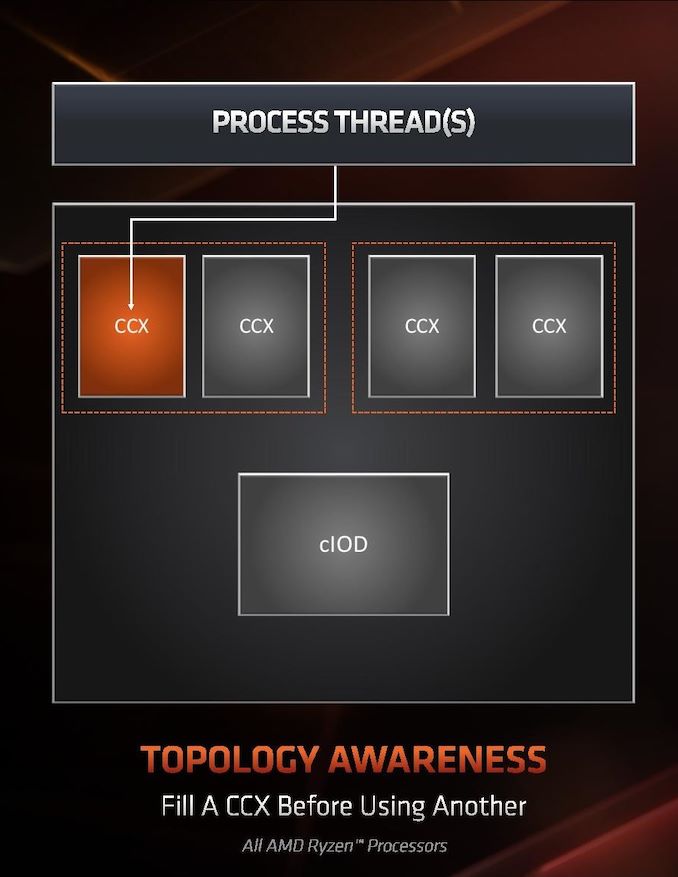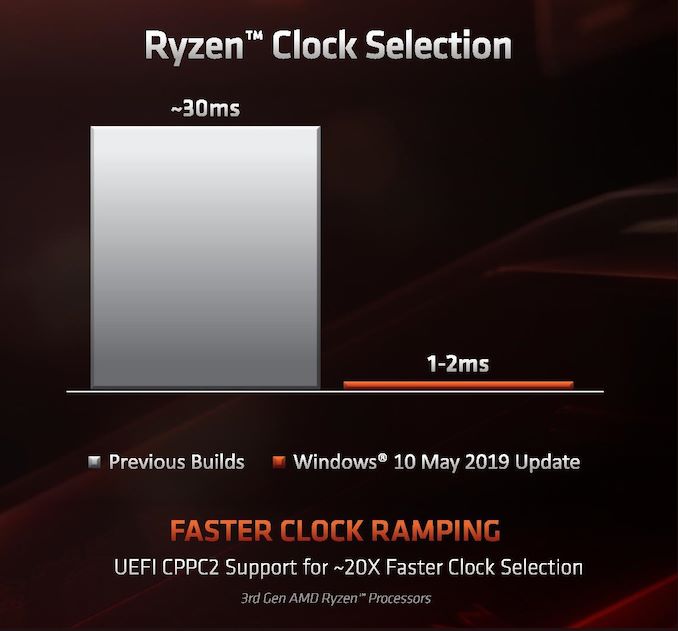AMD Zen 2 Microarchitecture Analysis: Ryzen 3000 and EPYC Rome
by Dr. Ian Cutress on June 10, 2019 7:22 PM EST- Posted in
- CPUs
- AMD
- Ryzen
- EPYC
- Infinity Fabric
- PCIe 4.0
- Zen 2
- Rome
- Ryzen 3000
- Ryzen 3rd Gen
Windows Optimizations
One of the key points that have been a pain in the side of non-Intel processors using Windows has been the optimizations and scheduler arrangements in the operating system. We’ve seen in the past how Windows has not been kind to non-Intel microarchitecture layouts, such as AMD’s previous module design in Bulldozer, the Qualcomm hybrid CPU strategy with Windows on Snapdragon, and more recently with multi-die arrangements on Threadripper that introduce different memory latency domains into consumer computing.
Obviously AMD has a close relationship with Microsoft when it comes down to identifying a non-regular core topology with a processor, and the two companies work towards ensuring that thread and memory assignments, absent of program driven direction, attempt to make the most out of the system. With the May 10th update to Windows, some additional features have been put in place to get the most out of the upcoming Zen 2 microarchitecture and Ryzen 3000 silicon layouts.
The optimizations come on two fronts, both of which are reasonably easy to explain.
Thread Grouping
The first is thread allocation. When a processor has different ‘groups’ of CPU cores, there are different ways in which threads are allocated, all of which have pros and cons. The two extremes for thread allocation come down to thread grouping and thread expansion.
Thread grouping is where as new threads are spawned, they will be allocated onto cores directly next to cores that already have threads. This keeps the threads close together, for thread-to-thread communication, however it can create regions of high power density, especially when there are many cores on the processor but only a couple are active.
Thread expansion is where cores are placed as far away from each other as possible. In AMD’s case, this would mean a second thread spawning on a different chiplet, or a different core complex/CCX, as far away as possible. This allows the CPU to maintain high performance by not having regions of high power density, typically providing the best turbo performance across multiple threads.
The danger of thread expansion is when a program spawns two threads that end up on different sides of the CPU. In Threadripper, this could even mean that the second thread was on a part of the CPU that had a long memory latency, causing an imbalance in the potential performance between the two threads, even though the cores those threads were on would have been at the higher turbo frequency.
Because of how modern software, and in particular video games, are now spawning multiple threads rather than relying on a single thread, and those threads need to talk to each other, AMD is moving from a hybrid thread expansion technique to a thread grouping technique. This means that one CCX will fill up with threads before another CCX is even accessed. AMD believes that despite the potential for high power density within a chiplet, while the other might be inactive, is still worth it for overall performance.
For Matisse, this should afford a nice improvement for limited thread scenarios, and on the face of the technology, gaming. It will be interesting to see how much of an affect this has on the upcoming EPYC Rome CPUs or future Threadripper designs. The single benchmark AMD provided in its explanation was Rocket League at 1080p Low, which reported a +15% frame rate gain.
Clock Ramping
For any of our users familiar with our Skylake microarchitecture deep dive, you may remember that Intel introduced a new feature called Speed Shift that enabled the processor to adjust between different P-states more freely, as well as ramping from idle to load very quickly – from 100 ms to 40ms in the first version in Skylake, then down to 15 ms with Kaby Lake. It did this by handing P-state control back from the OS to the processor, which reacted based on instruction throughput and request. With Zen 2, AMD is now enabling the same feature.
AMD already has sufficiently more granularity in its frequency adjustments over Intel, allowing for 25 MHz differences rather than 100 MHz differences, however enabling a faster ramp-to-load frequency jump is going to help AMD when it comes to very burst-driven workloads, such as WebXPRT (Intel’s favorite for this sort of demonstration). According to AMD, the way that this has been implemented with Zen 2 will require BIOS updates as well as moving to the Windows May 10th update, but it will reduce frequency ramping from ~30 milliseconds on Zen to ~1-2 milliseconds on Zen 2. It should be noted that this is much faster than the numbers Intel tends to provide.
The technical name for AMD’s implementation involves CPPC2, or Collaborative Power Performance Control 2, and AMD’s metrics state that this can increase burst workloads and also application loading. AMD cites a +6% performance gain in application launch times using PCMark10’s app launch sub-test.
Hardened Security for Zen 2
Another aspect to Zen 2 is AMD’s approach to heightened security requirements of modern processors. As has been reported, a good number of the recent array of side channel exploits do not affect AMD processors, primarily because of how AMD manages its TLB buffers that have always required additional security checks before most of this became an issue. Nonetheless, for the issues to which AMD is vulnerable, it has implemented a full hardware-based security platform for them.
The change here comes for the Speculative Store Bypass, known as Spectre v4, which AMD now has additional hardware to work in conjunction with the OS or virtual memory managers such as hypervisors in order to control. AMD doesn’t expect any performance change from these updates. Newer issues such as Foreshadow and Zombieload do not affect AMD processors.














216 Comments
View All Comments
fmcjw - Tuesday, June 11, 2019 - link
All good and fine, but I want Zen 2 and 7nm on my laptop. If they aren't announcing it today, products aren't gonna ship by holiday 2019, and most consumers will end up buying 10nm Intel devices. Missed chance.mode_13h - Tuesday, June 11, 2019 - link
Eh, they have perfectly good 12 nm laptop SoCs. 7 nm would've been nice, but it's hard to do everything at once.levizx - Tuesday, June 11, 2019 - link
Nope, those 12nm APUs have worse battery life (than current 8th Gen) and no TB3/USB4 support. I can't think of a reason where I would choose Ryzen 3xxxU over Ice Lakemode_13h - Tuesday, June 11, 2019 - link
Do price & availability count?Xyler94 - Tuesday, June 11, 2019 - link
Misleading remarks. Huawei was able to make a Ryzen APU have better battery life than an 8th gen processor. TB3 and USB4 aren't readily used mainstream yet. Heck USB-C hasn't even caught on yet.Currently laptop makers aren't optimizing AMD's CPU, that's just the fact.
Cooe - Wednesday, June 12, 2019 - link
This is mostly nonsense. Performance AND battery life for Ryzen Mobile 2nd Gen is extremely close to Intel's current 8th & 9th gen 4-core parts. And until Ice Lake is a real thing that you can actually buy, Ryzen still has a major value advantage + far better iGPU performance. Ice Lake also isn't really any faster CPU wise than Whiskey Lake, because despite increasing IPC by +18%, clock-speeds were dropped from 4.8 to 4.1GHz, or about -16%, erasing nearly all those gains.fmcjw - Tuesday, June 11, 2019 - link
Yeah, I get that they still need time to get the GPU down to 7nm, so they pushed it back to focus on the CPU for desktop (where performance per watt matters much less than server or mobile). But the silence is not reassuring, and mobile-wise, Zen is still inferior to Intel, maybe not performance-wise as Huawei demonstrates with its Matebook, but definitely battery-wise because of the more powerful GPU.scineram - Tuesday, June 11, 2019 - link
Nobody is going to buy Shintel vaporware. Or only very few.The_Assimilator - Tuesday, June 11, 2019 - link
Please edit the table on page 1 to combine the rows with identical values into a single row (e.g. the RAM speed). Also edit the 3950X price to have a ? after it as it's not yet confirmed.jfmonty2 - Tuesday, June 11, 2019 - link
The 3950X price is most definitely confirmed; Lisa Su said it loud and clear (and showed it on the slide) in AMD's E3 presentation yesterday: https://www.youtube.com/watch?v=yxPBXNuX6Xs&t=...